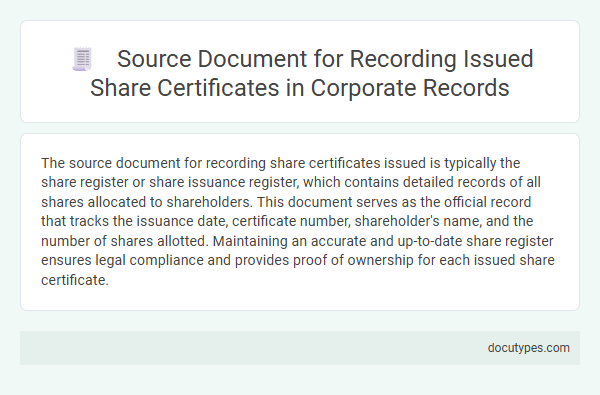The source document for recording share certificates issued is typically the share register or share issuance register, which contains detailed records of all shares allocated to shareholders. This document serves as the official record that tracks the issuance date, certificate number, shareholder's name, and the number of shares allotted. Maintaining an accurate and up-to-date share register ensures legal compliance and provides proof of ownership for each issued share certificate.
Introduction to Source Documents in Corporate Share Issuance
Source documents are essential for accurately recording share certificates issued by a corporation. These documents serve as the original evidence of share transactions and ownership details.
- Share Subscription Form - This form captures the investor's agreement to purchase shares and specifies the number of shares subscribed.
- Board Resolution - Official approval by the company's board authorizing the issuance of shares is documented here.
- Share Certificate - The physical or electronic certificate serves as proof of share ownership and must be recorded accordingly.
Proper documentation ensures transparent and compliant share issuance within corporate governance.
Definition and Purpose of Share Certificates
What is the source document for recording share certificates issued? The source document for recording share certificates issued is the share certificate itself, which acts as tangible proof of ownership in a corporation. Share certificates contain critical details such as the shareholder's name, the number of shares owned, and the date of issuance, ensuring accurate and legal recognition of ownership.
What is the definition and purpose of share certificates? A share certificate is an official document issued by a company to its shareholders, certifying ownership of a specific number of shares. Its purpose is to provide legal evidence of stock ownership, facilitate transfer of shares, and record shareholder information for corporate governance and regulatory compliance.
Legal Requirements for Issuing Share Certificates
The source document for recording share certificates issued is typically the company's share register or share issuance ledger. Legal requirements for issuing share certificates mandate accurate entry of shareholder details, share quantity, and certificate number to ensure ownership is properly documented. You must comply with jurisdiction-specific regulations to validate the certificate's legality and maintain transparent corporate records.
Types of Source Documents Used in Share Issuance
The source document for recording share certificates issued is essential for accurate company records. It serves as proof of ownership and validates the issuance of shares.
Types of source documents used in share issuance include share subscription agreements, share allotment letters, and share certificates themselves. You must retain these documents to ensure compliance and facilitate future audits.
Essential Information Recorded on Share Certificates
The source document for recording share certificates issued is the Share Register or Share Ledger maintained by a company. This document provides a comprehensive record of all shares issued, transferred, and cancelled.
Essential information recorded on share certificates ensures legal ownership and facilitates transparent shareholder management.
- Certificate Number - A unique identifier assigned to each share certificate for tracking and verification purposes.
- Shareholder's Name - The registered name of the individual or entity owning the shares as recorded in the Share Register.
- Number and Class of Shares - Specifies the exact quantity and category of shares represented by the certificate, confirming shareholder rights.
Procedures for Issuing and Recording Share Certificates
The source document for recording share certificates issued is a critical record that verifies ownership and transaction details. Proper procedures ensure accurate issuance and recording of share certificates to maintain corporate compliance.
- Share Certificate Register - Acts as the official ledger where all issued share certificates are recorded with details such as certificate number, shareholder name, and number of shares.
- Share Application Form - Serves as the initial document upon which share issuance is based, containing shareholder information and share allotment specifics.
- Board Resolution - Authorizes the issuance of shares and provides formal approval required before issuing and recording share certificates.
Role of Corporate Records in Share Certificate Management
| Topic | Source Document for Recording Share Certificates Issued |
|---|---|
| Definition | The source document is the original record or instrument that verifies the issuance of share certificates by a corporation. |
| Role of Corporate Records | Corporate records maintain detailed logs of issued share certificates, serving as the authoritative source for tracking ownership and ensuring compliance with legal and regulatory requirements. |
| Primary Source Document | The Share Register or Stock Ledger acts as the official source document. It records each share certificate issued, including certificate number, shareholder details, and the number of shares allocated. |
| Importance for Share Certificate Management | Accurate and up-to-date corporate records enable efficient share certificate management and prevent discrepancies in ownership data, reducing risks of fraud or errors in shareholder equity tracking. |
| Legal Compliance | Maintaining the Share Register and supporting documents complies with corporate governance standards and statutory requirements in jurisdictions regulating share issuance. |
Compliance and Audit Considerations for Source Documents
The source document for recording share certificates issued is the Share Certificate Register or Register of Members. This document serves as the official record of all share certificates issued by a company.
Compliance requires that the source document accurately reflects all details including shareholder names, certificate numbers, and issuance dates. Auditors review these records to verify the authenticity and completeness of share transactions. Maintaining precise and up-to-date registers ensures adherence to legal and regulatory obligations, reducing risk during audits.
Digital vs. Physical Share Certificate Documentation
The source document for recording share certificates issued varies between digital and physical formats. Digital share certificates rely on electronic records maintained in secure databases, while physical share certificates are documented through paper-based ledgers and official issuance forms.
Your choice between digital and physical documentation affects how transactions are tracked and validated. Digital certificates offer real-time updates and easy access, whereas physical certificates require manual handling and storage for accuracy and legal compliance.
What Is the Source Document for Recording Share Certificates Issued? Infographic

